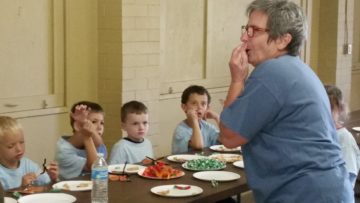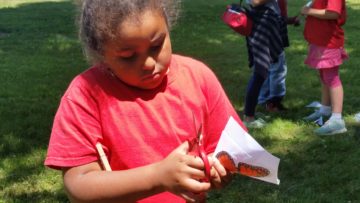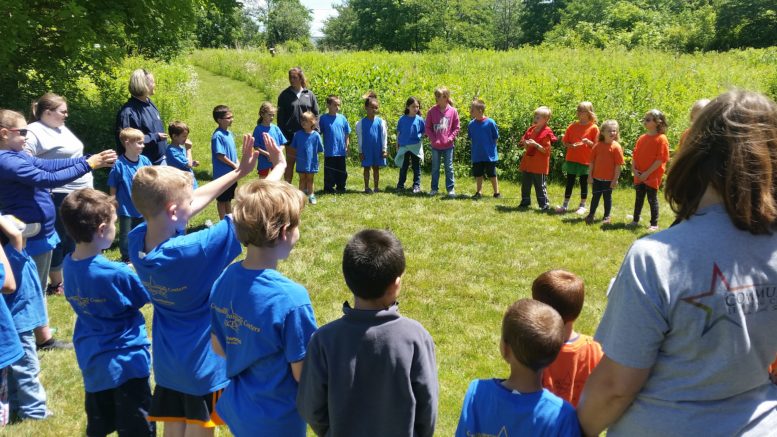By JAN LARSON McLAUGHLIN
BG Independent News
By the end of the day, nearly 250 kids left William Harrison Park – some wearing paper butterflies with pipe cleaner antennae in their hair, some with dirt on their hands, and some with new ideas in their heads.
Elementary age children from throughout Wood County gathered at the park in Pemberville for the annual Earth Camp Tuesday organized by the Wood County Solid Waste Management District for kids in the Community Learning Centers STARS program.
“We get every single one of the Community Learning kids outside for the entire day,” said Amanda Gamby, who coordinated the event. A parent herself, Gamby said sometimes after a long day at work, parents just don’t have the energy to take kids outside to play.
So for the 18th year, the Earth Camp gave them a full day to explore nature. This year’s theme was wildlife.
“It’s pretty great,” said Jamie Sands, with the Wood County Park District, which partnered on the camp. “This is for kids to be active in nature while learning about wildlife.”

Judy Hagen talks about Monarch butterflies.
Children went from station to station, learning about the declining Monarch butterfly population, “habitracks” using a map to explore habitat components for animals, the importance of pollination, local amphibians, and Nature’s Nursery.
“Then they get to go down to the river and see some critters,” Sands said. “They go home and they are probably all exhausted.”
At one station, the children learned about the efforts of Nature’s Nursery to help nurse wildlife back to health and return them to the wild. Some of the lessons focused on what the program does not do. Nature’s Nursery takes in 2,500 animals a year. The children guessed the types of animals are aided.
Sea turtles? “We don’t take care of sea turtles, no,” Marquita Tillotson, of Nature’s Nursery said. Snapping turtles, yes.
Fish? “Nobody ever calls us up and says, ‘we found a really sick fish,’” Tillotson said.
Rabbits? Yes. In fact, about half of the animals taken in at the nursery are rabbits. “Tons of little babies,” Tillotson said.
Beavers? No, but they would help a beaver if it was brought in.
Moles? “We do get moles. We got a cute little mole the other day,” Tillotson said.
When the animals are better, the nursery releases them back into the wild. Why?
“So they can do their own thing,” a child answered.
Why shouldn’t they keep the animals, Tillotson asked. If a child took in a raccoon and raised it as a pet, and dressed it in outfits, “would it love you forever and ever? No it’s still a wild animal.”

Nahla Drones, 6, of Bowling Green, cuts out paper Monarch.
At another Earth Camp station, children were learning about pollination. Bryan Bockbrader, of the Wood County Park District, was quizzing the kids on pollination facts. Which foods depend on pollination? Coffee, chili peppers, potatoes, apples? All of them, he said.
At another station, kids were learning about amphibians from park district naturalist Craig Spicer. And at another, they learned about Monarch butterflies from Judy Hagen, from the city of Perrysburg. They heard how instinct hard-wired into Monarchs leads them on their annual migrations, how their orange coloring tricks birds into thinking they are poisonous to eat, and how Monarch eggs are planted into milkweed – which is not nearly as prolific as it used to be, resulting in declining Monarch populations.
By the end of the day, children were pointing out animal habitats throughout the park, looking for animal tracks, and fastening pipe cleaner antennae to their butterflies. And if Gamby is right, they went home exhausted, but also knowing a lot more about wildlife.

